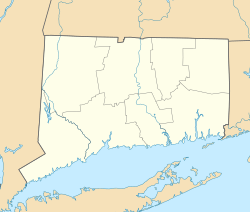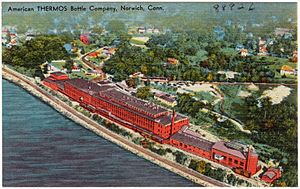American Thermos Bottle Company Laurel Hill Plant facts for kids
Quick facts for kids |
|
|
American Thermos Bottle Company Laurel Hill Plant
|
|
 |
|
| Location | 11 Thermos Avenue, Norwich, Connecticut |
|---|---|
| Area | 8.7 acres (3.5 ha) |
| Built | Varies |
| Architectural style | Varies |
| NRHP reference No. | 88003091 |
| Added to NRHP | July 17, 1989 |
The American Thermos Bottle Company Laurel Hill Plant is a historic factory complex. It is located in the Laurel Hill area of Norwich, Connecticut. This plant was the main factory where Thermos brand vacuum flask bottles were made. This happened from 1913 to 1984.
The plant is important because of its connection to the Thermos Company. It also shows how old industrial buildings can be used for new purposes. The complex was added to the National Register of Historic Places in 1989. Since then, many parts of the plant have been changed. Some areas now have condominiums, and a large factory building became loft-style apartments. Part of the property was also changed to build the Integrated Day Charter School.
Contents
How the Thermos Plant Started
The people of Norwich, Connecticut, really wanted the Thermos company to build a factory there. They wanted to create jobs. A group called "Norwich Boomers" helped the community buy about 27 acres of land. This land was for the Thermos Plant. An old house on the land, belonging to Dr. William H. Mason, was bought too. This Italianate style house was turned into the company's office.
The citizens and the city worked together and raised $78,000. On February 14, 1912, a contract was signed. This made Norwich the home of the Thermos Plant. In return, Thermos promised to mention Norwich in their ads. They even marked products made there with "Made in Norwich." Building the plant was a big help for Norwich. It brought many jobs after the local textile industry had slowed down.
What the Plant Looked Like
The Thermos plant was built along the Thames River. It had many buildings connected together and some standing alone. The main part of the plant was a group of buildings linked for production.
The original plant had the company offices and a large Manufacturing Building. The Mason house, built in 1861, became the company office. It was a two-story brick house. Over the years, it was changed a lot to fit its new use. The Manufacturing building was built from 1912 to 1913. It was three stories high on the river side.
Other buildings were added over time. The Human Resources and Research and Development buildings were first built around 1912. Thermos bought them in 1923. A Carpenter Shop was built in 1926. More storage buildings were added in 1929 and 1941. Glass House 1 was built in 1939, and Glass House 2 was built in 1951.
Modern Changes and Uses
In the 1990s, the plant was used as a filming location for the movie Everybody Wins. After that, parts of the property were turned into condominiums. The factory building was also changed into loft-style apartments.
In 1997, the Integrated Day Charter School renovated about 16,000 square feet of the factory. This space became a school. To make room for a playground and parking, two old buildings had to be taken down. The school opened in August 1997. It serves students from pre-kindergarten to eighth grade. Most students live in Norwich.
Since the plant was added to the National Register of Historic Places, many changes have happened. The Integrated Day Charter School's construction removed some older buildings. In 2008, a new two-story addition was built for the school. This added an indoor gym, kitchen, offices, and a new lobby. The large Manufacturing building was also updated. It got new windows, energy-efficient roofing, and modern systems.
Why This Plant is Important
The American Thermos Bottle Company Laurel Hill Plant is important for several reasons. It was the main factory that made Thermos bottles. This helped the company become a leader in the world market. It also shows how the Norwich community worked together to bring new businesses to the area. This helped to create different types of jobs locally.
The plant is also important for its architecture. It shows how industrial buildings from the late 1800s and early 1900s were changed for new types of industries. The American Thermos Bottle Company Laurel Hill Plant was added to the National Register of Historic Places in 1989.
Images for kids




